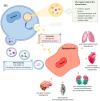Endothelial Progenitor Cell-Derived Extracellular Vesicles: Potential Therapeutic Application in Tissue Repair and Regeneration
- PMID: 34203627
- PMCID: PMC8232313
- DOI: 10.3390/ijms22126375
Endothelial Progenitor Cell-Derived Extracellular Vesicles: Potential Therapeutic Application in Tissue Repair and Regeneration
Abstract
Recently, many studies investigated the role of a specific type of stem cell named the endothelial progenitor cell (EPC) in tissue regeneration and repair. EPCs represent a heterogeneous population of mononuclear cells resident in the adult bone marrow. EPCs can migrate and differentiate in injured sites or act in a paracrine way. Among the EPCs' secretome, extracellular vesicles (EVs) gained relevance due to their possible use for cell-free biological therapy. They are more biocompatible, less immunogenic, and present a lower oncological risk compared to cell-based options. EVs can efficiently pass the pulmonary filter and deliver to target tissues different molecules, such as micro-RNA, growth factors, cytokines, chemokines, and non-coding RNAs. Their effects are often analogous to their cellular counterparts, and EPC-derived EVs have been tested in vitro and on animal models to treat several medical conditions, including ischemic stroke, myocardial infarction, diabetes, and acute kidney injury. EPC-derived EVs have also been studied for bone, brain, and lung regeneration and as carriers for drug delivery. This review will discuss the pre-clinical evidence regarding EPC-derived EVs in the different disease models and regenerative settings. Moreover, we will discuss the translation of their use into clinical practice and the possible limitations of this process.
Keywords: endothelial progenitor cells; extracellular vesicles; injury; recipient cells; tissue regeneration.
Conflict of interest statement
The authors declare no conflict of interest.
Figures
References
-
- Kalka C., Masuda H., Takahashi T., Kalka-Moll W.M., Silver M., Kearney M., Li T., Isner J.M., Asahara T. Transplantation of ex vivo expanded endothelial progenitor cells for therapeutic neovascularization. Proc. Natl. Acad. Sci. USA. 2000;97:3422–3427. doi: 10.1073/pnas.97.7.3422. - DOI - PMC - PubMed
-
- Loomans C., Wan H., De Crom R., Van Haperen R., De Boer H., Leenen P., Drexhage H., Rabelink T., Van Zonneveld A., Staal F. Angiogenic Murine Endothelial Progenitor Cells Are Derived From a Myeloid Bone Marrow Fraction and Can Be Identified by Endothelial NO Synthase Expression. Arter. Thromb. Vasc. Biol. 2006;26:1760–1767. doi: 10.1161/01.ATV.0000229243.49320.c9. - DOI - PubMed
-
- Ratajczak J., Kucia M., Mierzejewska K., Marlicz W., Pietrzkowski Z., Wojakowski W., Greco N.J., Tendera M., Ratajczak M.Z. Paracrine Proangiopoietic Effects of Human Umbilical Cord Blood-Derived Purified CD133+Cells—Implications for Stem Cell Therapies in Regenerative Medicine. Stem Cells Dev. 2013;22:422–430. doi: 10.1089/scd.2012.0268. - DOI - PMC - PubMed
Publication types
MeSH terms
LinkOut - more resources
Full Text Sources


